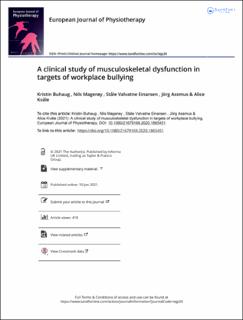A clinical study of musculoskeletal dysfunction in targets of workplace bullying
Journal article, Peer reviewed
Published version

Åpne
Permanent lenke
https://hdl.handle.net/11250/2766045Utgivelsesdato
2021Metadata
Vis full innførselSamlinger
- Department of Psychosocial Science [865]
- Registrations from Cristin [10412]
Sammendrag
Background
Workers exposed to bullying often report musculoskeletal symptoms. In this study we have clinically evaluated the prevalence and nature of musculoskeletal dysfunction among a group of workers exposed to bullying and studied the relationship between clinical findings and self-reported musculoskeletal and mental symptoms.
Materials and methods
In a cross-sectional study, 144 patients admitted to an outpatient clinic for victims of workplace bullying were assessed with the Global Physiotherapy Examination 52 (GPE-52), a standardised test battery examining posture, respiration, movement, muscle and skin. The patients filled in self-report questionnaires regarding musculoskeletal symptoms (MSI), anxiety and depression (The Hospital Anxiety and Depression Scale, HADS) and post-traumatic stress symptoms (Impact of Events Scale revised version, IES-R).
Results
Patients victimised by bullying showed reduced flexibility, reduced ability to relax, restricted respiration and tense and painful muscles. The total GPE-52 sum-score and the main domains Movement and Muscle had significant correlations with most self-reported health variables, strongest between the subdomain Flexibility and HADS-D (r = 0.37) and HADS-A (r = 0.36).
Conclusions
Victims of bullying have clinically evident musculoskeletal dysfunctions that were further found to have a relationship with self-reported mental symptoms. Future health services for these patients should be multi-dimensional and include a bodily assessment by a physiotherapist and relevant treatment when needed.
